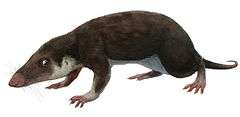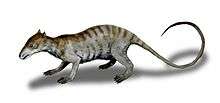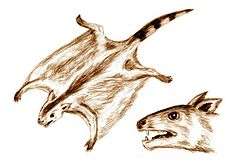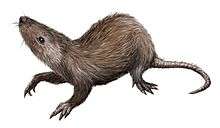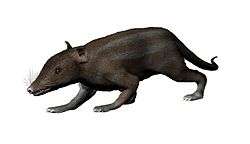Dryolestoidea
Dryolestoidea is an extinct clade of Mesozoic mammals that only contains two orders. It has been suggested that this group is closely related to modern therian mammals.
| Dryolestoidea | |
|---|---|
| Scientific classification | |
| Kingdom: | Animalia |
| Phylum: | Chordata |
| Class: | Mammalia |
| Clade: | Cladotheria |
| Superorder: | †Dryolestoidea Butler 1939 |
| Orders | |
Characteristics
_(17536568193).jpg)
Dryolestids are mostly represented by teeth, fragmented dentaries and parts of the rostrum. The Jurassic forms retained a coronoid and splenial, but the Cretaceous forms lack these. Another primitive feature is the presence of a Meckelian groove (Meridiolestidans lost it altogether).[1] A fundamentally modern ear is known in at least Dryolestes and mesungulatids.[2][3]
Tooth enamel evolved differently in marsupials and eutherians. In a first phase, during the late Triassic and Jurassic, prisms separated from the interprismatic matrix, probably independently in several Mesozoic mammal lineages. More derived enamel types evolved in a second phase, during the Tertiary and Quaternary, but without replacing the old prismatic enamel, instead forming various combinations of three-dimensional structures (called schmelzmuster). Dryolestid dentition is thought to resemble the primitive mammalian dentition before the marsupial-eutherian differentiation and dryolestids are candidates to be the last common ancestor of the two mammalian subclasses.[4]
Two dryolestoids, Drescheratherium and Cronopio, have elongated upper canines.[5]
Distribution
Dryolestoids are known from the Jurassic through Early Cretaceous of the northern hemisphere (North America, Eurasia, and North Africa) and from the Late Cretaceous through to the Miocene of South America.[1] Drylestoids are very rarely found in the Cenozoic, as are the few other Mesozoic mammals with later descendants, such as multituberculates, monotremes, and gondwanatheres.[6]
The oldest undisputed fossils of Dryolestidae were found in the Guimarota coal mine near Leiria, Portugal, the largest known deposit of Jurassic mammals. The tooth pattern of these fossils — 8–9 mesiodistally compressed molars with small, cusp-like talonids — distinguish them from tribosphenic mammals, and they form a sister group of the latter and Peramus together with Amphitherium, Paurodontidae, and Henkelotheriidae.[7]
The youngest fossil in the northern hemisphere is Crusafontia cuencana from early Cretaceous of Uña and Galve, Spain, though a fragmentary lower molar from the late Cretaceous Mesaverde Formation in Wyoming has been attributed to Dryolestidae. In South America, by contrast, dryolestoids thrived in the Late Cretaceous, diversifying in a myriad of forms such as the saber-toothed Cronopio or the herbivorous mesungulatids, becoming some of the most ecologically diverse Mesozoic South American mammals.[8] At least two major Late Cretaceous South American dryolestoid clades are known: Meridiolestida and a clade similar to Dryolestes itself, Groebertherium.[9]
With the advent of the Cenozoic, dryolestoids declined drastically in diversity, with only Peligrotherium being known from the Palaeocene. The exact reasons for this decline aren't clear; most likely they simply did not recover from the K-Pg event. Nonetheless, dryolestoids would continue to survive until the Miocene, from when Necrolestes is known; a gap of 50 million years exists between it and Peligrotherium.[10] A possible brandoniid tooth was described from the Eocene of Antarctica, although could rather represent a necrolestid.[11]
References
- Kielan-Jaworowska, Cifelli & Luo 2004, pp. 14, 375, 379–380
- Rougier, Guillermo W. (2009). "Mammals from the Allen Formation, Late Cretaceous, Argentina". Cretaceous Research. 30: 223–238. doi:10.1016/j.cretres.2008.07.006.
- ZHE-XI, LUO; RUF; Irina; Martin, Thomas (2012). "The petrosal and inner ear of the Late Jurassic cladotherian mammal Dryolestes leiriensis and implications for ear evolution in therian mammals". Zoological Journal of the Linnean Society. 166: 433–463. doi:10.1111/j.1096-3642.2012.00852.x.
- von Koenigswald 2000, p. 107
- Rougier, Guillermo W.; Apesteguía, Sebastián; Gaetano, Leandro C. (2011). "Highly specialized mammalian skulls from the Late Cretaceous of South America". Nature. 479: 98–102. doi:10.1038/nature10591. PMID 22051679.
- Rose 2006, pp. 335–6
- Martin 1997, Introduction
- Rougier et al. 2009, p. 208.
- Harper T, Parras A, Rougier GW. 2018. Reigitherium (Meridiolestida, Mesungulatoidea) an enigmatic Late Cretaceous mammal from Patagonia, Argentina: morphology, affinities, and dental evolution. Journal of Mammalian Evolution.
- Florentino Ameghino (1891). "Nuevos restos de mamíferos fósiles descubiertos por Carlos Ameghino en el Eoceno inferior de la Patagonia austral. Especies nuevas, adiciones y correciones". Revista Argentina de Historia Natural. 1: 289–328.
- Gelfo, J. N.; Bausza, N.; Reguero, M. (2019). "The fossil record of Antarctic land mammals: commented review and hypotheses for future research". Advances in Polar Science: 274–292.
Bibliography
- Butler, PM (December 1939). "The Teeth of the Jurassic Mammals". Proceedings of the Zoological Society of London. B. 109 (3–4): 329–356. doi:10.1111/j.1096-3642.1939.tb00719.x.CS1 maint: ref=harv (link)
- Kielan-Jaworowska, Zofia; Cifelli, Richard L; Luo, Zhe-Xi (2004). Mammals from the Age of Dinosaurs: Origins, Evolution, and Structure. New York: Columbia University Press. ISBN 978-0-231-11918-4.CS1 maint: ref=harv (link)
- Martin, Thomas (1997). "Tooth Replacement in Late Jurassic Dryolestidae (Eupantotheria, Mammalia)". Journal of Mammalian Evolution. 4 (1): 1–18. doi:10.1023/A:1027300726126. OCLC 360227463.CS1 maint: ref=harv (link)
- Rose, Kenneth David (2006). The beginning of the age of mammals. Baltimore: JHU Press. ISBN 0801884721.CS1 maint: ref=harv (link)
- von Koenigswald, Wighart (2000). "Two different strategies in enamel differentiation: Marsupialia versus Eutheria". In Teaford, Mark F; Smith, Moya Meredith; Ferguson, Mark WJ (eds.). Development, Function and Evolution of Teeth. Cambridge University Press. ISBN 978-0-511-06568-2.CS1 maint: ref=harv (link)
